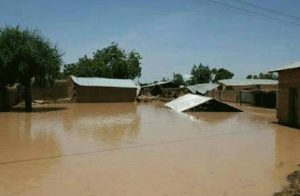By Hon Sadiq Ibrahim Dasin
* The Dasin Hausa dam would cushion the effect of the annual flooding from the Cameroon’s Lagdo dam
* Would generate 300mw of electricity
* Would irrigate about 150,000 hectares of land (and provide crop tonnage of 790,000 tons in Adamawa, Taraba and Benue states)
* Would provide employment opportunities for 40,000 families
* Would make available navigational route on the Benue River from Garoua in Cameroon republic to the Niger Delta
* Unfortunately in the absence of federal intervention, successive state governments have also failed to turn our abundant water resources into wealth
* But here, we are squeezing river Chochi as we keep building houses and pushing the water back from Yolde Pate to 80 Units estate
* We have extended Fadde Sanda, Fadde Magaji, Fadde Yelwa, and Damare because of which today, Njuwa has disappeared.
* Successive state governments have ignored building water reservoirs for cattle farming, for fishing, rice and vegetables dry season farming on Mayo Kabi, Mayo Tiyel, Mayo Kilange, Mayo Faro, Mayo Beti, Mayo Pambambi, Mayo Chochi, Mayo Ine
* We just waste water and depend on rain fed agriculture
* We have no reason to be poor in Adamawa, if only we can develop our water resources
We are in the raining season again. But I am beginning to feel like I should not care anymore because for people living in Adamawa’s Benue valley, every season makes us poorer.

In the raining season, we waste harvestable water, suffer destructive flooding and loss of nutrients from our land.
In the dry season when the rivers dry out, fishermen, dry season farmers, livestock farmers all get poorer.
In this season, businessmen also become poorer as travel routes for commerce on the river get blocked. Even our children now lose recreation on the riverbank.
Yet Nigeria’s federal government has refused to construct a water reservoir on the river at Dasin Hausa despite millions of Naira spent on the project’s feasibility studies conducted by a Brazilian company in 1982, shortly after I left secondary school.
What I read in the project report by the consultants to the project shocks me every day.
The consultants have written in their report that ”the Dasin Hausa dam would cushion the effect of the annual flooding from the Cameroon’s Lagdo dam, generate 300mw of electricity and irrigate about 150,000 hectares of land (and provide crop tonnage of 790,000 tons in Adamawa, Taraba and Benue states), provide employment opportunities for 40,000 families and make available navigational route on the Benue River from Garoua in Cameroon republic to the Niger Delta”. Despite this, no Nigerian government found it necessary to act.
While Cameroon had built their own dam on the river at a place called Lagdo in 1982 and the dam provides them with electricity 24/7, provides their northern province with potable water and is irrigating farmlands in Garoua, the only thing Nigeria has done was mere feasibility study also in 1982 “to build a water withholding dam at Dasin Hausa”. 38 years after, the plan is still on the drawing board.
Meanwhile in Wuro Bokki, Pariya, Ribadu, Dasin, Rugange Njoboliyo, Yola, Jimeta, Numan, Lamorde and in many towns and villages along the river bank, the impacts of the flood on local people are devastating. Human lives, houses and properties including farmlands and animals are being lost every year while economic activities are reduced due to washed roads and sicknesses such as diarrhoea, malaria and snakebites caused by the rising water as a result of the floods.
Unfortunately in the absence of federal intervention, successive state governments have also failed to turn our abundant water resources into wealth.
In the republic of Mali, the river Niger that divided Bamako into 2 parts is the river that divided Niamey, Niger Republic into 2.
In these 2 poor countries located in the desert, dry season vegetables such as salads, carrot, tomato, onions, courgette, cauliflower, cabbage, lettuce, spinach, etc that are grown on the river banks are served fresh with every meal.
But here, we are squeezing river Chochi as we keep building houses and pushing the water back from Yolde Pate to 80 Units estate. We have extended Fadde Sanda, Fadde Magaji, Fadde Yelwa, and Damare because of which today, Njuwa has disappeared.
Successive state governments have ignored building water reservoirs for cattle farming, for fishing, rice and vegetables dry season farming on Mayo Kabi, Mayo Tiyel, Mayo Kilange, Mayo Faro, Mayo Beti, Mayo Pambambi, Mayo Chochi, Mayo Ine, etc. If we had done so, we would have reduced poverty and guarantee food security. We just waste water and depend on rain fed agriculture.
In any case these days there is what is called BOT – Build, Operate and Transfer. Even the state government can get a Chinese company to build the Dasin Hausa dam, operate it and transfer it back to the state government after an agreed period of time.
China International Water & Electric Corp. built the Lagdo dam. AES Sonel, a French company runs the hydroelectric dam.
Today in Cameroon you go to jail for failing to pay electricity bill or for bypassing electricity cable. Federal government of Nigeria and Nigeria’s electricity consumers are both not serious.
From the above, it is quite clear that we have no reason to be poor in Adamawa to the extent of being the third poorest state in Nigeria in 2019 if only we can develop our water resources for electricity generation, animal husbandry, fishing, rice and vegetables farming. We are just people with no eye on the future. We do not focus on what is coming nor do we plan. I so submit.